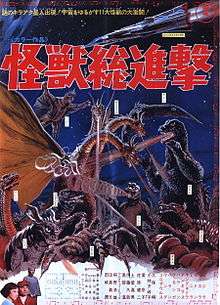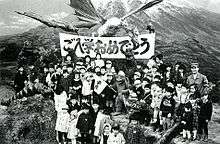Destroy All Monsters
| Destroy All Monsters | |
|---|---|
 | |
| Directed by | Ishirō Honda |
| Produced by | Tomoyuki Tanaka |
| Written by |
Ishirō Honda Takeshi Kimura |
| Starring |
Akira Kubo Jun Tazaki Yukiko Kobayashi Yoshio Tsuchiya Kyôko Ai |
| Music by | Akira Ifukube |
| Cinematography | Taiichi Kankura |
| Edited by | Ryohei Fujii |
Production company | |
| Distributed by |
Toho (Japan) AIP (USA) |
Release dates |
|
Running time | 88 minutes |
| Language | Japanese |
Destroy All Monsters, released in Japan as Kaijū Sōshingeki (怪獣総進撃, lit. "Attack of the Marching Monsters"), is a 1968 Japanese science-fiction kaiju film produced by Toho. The ninth entry in the original Godzilla series, it stars Akira Kubo, Jun Tazaki, Yukiko Kobayashi and Yoshio Tsuchiya. Produced in celebration as Toho's 20th kaiju film, it was also originally intended to be the final Godzilla film,[1] and as such, was given a bigger budget than the past few productions. Set at the end of the 20th century, the film features many of Toho's earlier monsters, eleven in all. The film was also the last to be produced by the main creators of the Godzilla character, with Ishirō Honda directing, Eiji Tsuburaya supervising the special effects, Tomoyuki Tanaka producing, and Akira Ifukube handling the film's score.
The film was released theatrically in the United States starting in May 1969 by American International Pictures.[2]
Plot
At the close of the 20th century, all of the Earth's kaiju have been collected by the United Nations Science Committee and confined in an area known as Monsterland, located in the Ogasawara island chain. A special control center is constructed underneath the island to ensure that the monsters stay secure, and to serve as a research facility to study them.
When communications with Monsterland are suddenly and mysteriously severed, and all of the monsters begin attacking world capitals, Dr. Yoshida of the UNSC orders Captain Yamabe and the crew of his spaceship, Moonlight SY-3, to investigate Ogasawara. There, they discover that the scientists, led by Dr. Otani, have become mind-controlled slaves of a feminine alien race identifying themselves as the Kilaaks, who reveal that they are in control of the monsters. Their leader demands that the human race surrender, or face total annihilation.
Godzilla attacks New York City, Rodan invades Moscow, Mothra (a larvae offspring) lays waste to Beijing, Gorosaurus (wrongly identified as Baragon...who might have dug the tunnel the former emerges from) destroys Paris, and Manda attacks London. These attacks were set in to motion to draw attention away from Japan, so that the aliens can establish an underground stronghold near Mt. Fuji in Japan. The Kilaaks then turn their next major attack on to Tokyo and, without serious opposition, become arrogant in their aims, until the UNSC discover that the Kilaaks have switched to broadcasting the control signals from their base under the Moon's surface. In a desperate battle, the crew of the SY-3 destroys the Kilaak's lunar outpost and returns the alien control system to Earth.
With all of the monsters under the control of the UNSC, the Kilaaks unleash their hidden weapon, King Ghidorah. The three-headed space monster is dispatched to protect the alien stronghold at Mt. Fuji, and battles Godzilla, Minilla, Mothra, Rodan, Gorosaurus, Anguirus, and Kumonga (Manda, Baragon and an unnamed Varan are also present but do not take part in the battle). While seemingly invincible, King Ghidorah is eventually overpowered by the combined strength of the Earth monsters and is killed. Refusing to admit defeat, the Kilaaks produce their trump card, a burning monster they call the Fire Dragon, which begins to torch cities and destroys the control center on Ogasawara. Suddenly, Godzilla attacks and destroys the Kilaak's underground base, revealing that the Earth's monsters instinctively know who their enemies are. Captain Yamabe then pursues the Fire Dragon in the SY-3, and narrowly achieves victory for the human race. The Fire Dragon is revealed to be a flaming Kilaak saucer and is destroyed. Godzilla and the other monsters are eventually returned to Monsterland to live in peace.
Cast
- Akira Kubo as Captain Katsuo Yamabe
- Jun Tazaki as Dr. Yoshido
- Yukiko Kobayashi as Kyoko Manabe
- Yoshio Tsuchiya as Dr. Otani
- Kyoko Ai as Kilaaks Queen
- Andrew Hughes as Dr. Stevenson
- Kenji Sahara as Nishikawa, Moon Base Commander
- Chotaro Togin as Astronaut Okada
- Yoshifumi Tajima as Major Tada
- Haruo Nakajima as Military Advisor; Godzilla
- Susumu Utsumi as King Ghidorah
- Hiroshi Sekita as Anguirus
Keiko Miyauchi, Atsuko Takahashi, Yoshio Miyata, Ari Sagawa, Kyoko Mori, Midori Uchiyama, Wakako Tanabe, and Michiko Ishii appear as the Kilaaks.[3] Kazuo Suzuki, Toru Ibuki, Susumu Kurobe, and Minoru Ito appear as Kilaakian-controlled staffers.
Production
Original screenplay
There was an initial screenplay with the preliminary title All Monsters Attack Directive, which would have many of the same elements used in the final product. The difference, however, was in the monster line-up. This first draft included several monsters that would appear in the final film, such as Godzilla, Mothra, King Ghidorah, Rodan, Baragon, Varan, Kumonga, and Manda. The final two monsters were Maguma (from 1962's Gorath) and Ebirah (from 1966's Godzilla vs. the Sea Monster). Maguma was to be one of the guardians of the Kilaak base with Baragon, who would have been the ones to fend off the SDF. Ebirah's role is unknown. The film’s title was later changed to Kaiju Soshingeki (Charge of the Monsters), and Ebirah and Maguma were replaced with Anguirus, Minilla and Gorosaurus.
Release and reception
Critical reception
Destroy All Monsters has been generally well received. The New York Times did not review the film upon release, but film critic Howard Thompson gave it a positive review on a re-release at a children's matinee in December 1970. He commented that "the feature wasn't bad at all of this type. The trick photography and especially the blended sweep and skill of the miniature settings provided the visual splash. The human beings, with good dubbed English voices, were a personable lot as they wrestled with some outer space culprits who had rounded up Japan's favorite monsters and turned them against the planet earth."
Among modern critics, Steve Biodrowski of Cinefantastique wrote, "In the end, Destroy All Monsters is too slim in its storyline, too thin in its characterizations, to be considered a truly great film. It is not as impressive as the original Godzilla, and it is not as hip as Monster Zero. But for the ten-year-old living inside us all, it is entertainment of the most awesome sort."[4] Matt Paprocki of Blogcritics said the film is "far from perfect" and "can be downright boring at times" but felt that "the destruction scenes make up for everything else" and "the final battle is an epic that simply can't be matched".[5]
On the review aggregator website Rotten Tomatoes, the film has a fresh rating of 71%.
American version


American International Pictures released the film theatrically in North America in 1969. The Americanization was handled by Titan Productions (formerly Titra Studios).
Among the changes for the U.S. release:
• The Toho logo and the accompanying section of Ifukube's score are cut. The AIP logo and title card appear over the background originally used for the Japanese title card, and the score picks up at the appropriate spot as well.
• The opening credits are removed. There is a straight cut from the shot of the Moonlight SY-3 cockpit to the overhead shot of Ogasawara Island that comes after the credits in the Japanese version.
• The scene transition from Dr. Otani aboard the SY-3 leaving Monsterland to him riding in the back of a car with Katsuo and Dr. Yoshida is altered; where the Japanese version used an optical wipe to transition from a close-up on Dr. Otani to a close-up of Katsuo that pans over to Otani and Yoshida, the AIP version cuts directly from Otani aboard the rocket to Otani in the car, keeping his face framed in almost the same spot.
• The pan across the aftermath of Godzilla, Rodan, Mothra and Manda's rampage through Tokyo ends sooner in the AIP version. The Japanese version ends by zooming in on a sign in Japanese bearing the name of some sort of emergency bunker or headquarters, then cuts to Katsuo inside. The AIP version cuts the sign and goes straight from the wreckage to Katsuo.
• There is one shot of the SY-3 landing in the Kilaak base on the moon that seems to be longer in the AIP version. It's a brief shot but it is notable.
• Not one, but two shots of Minilla are cut from the battle with King Ghidorah: One as Mothra and Kumonga spray Ghidorah with silk and webbing, and one as Angilas loses his grip on Ghidorah's neck and falls to the ground.
• The final shot of Ogasawara Island, there the "The End" title appears, is longer in the AIP version, and the title appears much later.
• The film's credits are displayed at the end over a black background, using the music cue that played under the opening credits in the Japanese version. Notably, Ishiro Honda's name is spelled correctly, as opposed to the commonly-used incorrect Romanization "Inoshiro."
In the Japanese version, the credits come right after the Moonlight SY-3 blasts off at the beginning of the movie. The American version moved the credits to the end of the picture.
This version has been replaced on home video and television by Toho's international version. While uncut and letterboxed, it features an English dub track produced by William Ross' Tokyo-based Frontier Enterprises in 1968.[6]
Home media
The film was first released on DVD in 1999, by ADV Films, with one standard release as well as a "50th Anniversary Special Edition release" which includes a soundtrack CD.[7][8] In 2011, Tokyo Shock released the film on DVD, and in 2014, the company re-released it on Blu-ray.[9]
Legacy
In Godzilla: The Series, the three-part "Monster Wars" story appears to have been inspired by Destroy All Monsters, with aliens taking control of Godzilla and other giant creatures and using them to attack the world's cities in preparation for invasion. At the end, their island hideout is used as a secret reserve for the surviving monsters.
Godzilla director Gareth Edwards has expressed an interest in making a sequel to his 2014 movie inspired by Destroy All Monsters.[10]
References
- ↑ August Ragone. Eiji Tsuburaya: Master of Monsters. Chronicle Books, 2007. Pg.171
- ↑ August Ragone. Eiji Tsuburaya: Master of Monsters. Chronicle Books, 2007. Pg.172
- ↑ Galbraith IV, Stuart (16 May 2008). The Toho Studios Story: A History and Complete Filmography. Google Books: Scarecrow Press. ISBN 978-0810860049.
- ↑ Destroy All Monsters (1968) - Kaiju Review | Cinefantastique Online
- ↑ Destroy All Monsters DVD Review - Blogcritics Video
- ↑ Steve Ryfle. Japan's Favourite Mon-Star. ECW Press, 1998. Pgs.152-153
- ↑ "DVD: Destroy All Monsters! (ADV Films)". Toho Kingdom. Retrieved 16 November 2016.
- ↑ "DVD: Destroy All Monsters - 50th Anniversary Special Edition (ADV Films)". Toho Kingdom. Retrieved 16 November 2016.
- ↑ J Hurtado (12 December 2011). "DESTROY ALL MONSTERS Blu-ray Review". Screen Anarchy. Retrieved 16 November 2016.
- ↑ Kendrick, Ben. "'Godzilla' Reboot Director Talks Creature Design; Sequel Ideas Inspired by 'Destroy All Monsters'". ScreenRant. Retrieved July 25, 2013.
- Thompson, Howard. Destroy All Monsters (film review). The New York Times. December 14, 1970.
Bibliography
- Ragone, August (2007, 2014). Eiji Tsuburaya: Master of Monsters San Francisco, California: Chronicle Books. ISBN 978-0-8118-6078-9
omgitsgodzilla, Toho Kingdom, Topic: Destroy All Monsters HD AIP Reconstruction. http://www.tohokingdom.com/forum/viewtopic.php?f=19&t=25447
External links
| Wikiquote has quotations related to: Destroy All Monsters |
- Godzilla on the web(Japan)
- Destroy All Monsters at the Internet Movie Database
- Destroy All Monsters at Rotten Tomatoes
- "怪獣総進撃 (Kaijū Sōshingeki)" (in Japanese). Japanese Movie Database. Retrieved 2007-07-18.